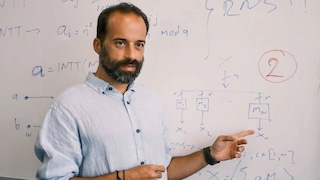Quantum technologies
Welcome to the new quantum age

We are entering an exciting new technological era where we can harness the power of individual quantum particles to create a new generation of technology. These quantum technologies will give rise to unparalleled computational capabilities. They will sense new phenomena, increasing our knowledge of the physical world. These technologies will redefine our understanding of the fundamentals of communication and reshape our notions of security and privacy. As this new quantum revolution unfolds, Nokia is tapping into its enormous potential to create new opportunities for our customers.
Quantum physics is reshaping the fundamentals of networking
Nokia Bell Labs is manipulating photons of light in new ways, leading to new possibilities in optical communications.
What are quantum technologies?
The range of quantum technologies is quite broad, encompassing far more than just quantum computing. Nokia is putting quantum mechanics to use as a tool for communication, privacy and detection, as well as computation.
Nokia categorizes quantum technologies into four distinct areas:
- Quantum computing harnesses the quantum states of individual particles, called qubits, to perform complex calculations no classical computer could ever match. Our researchers are investigating topological and photonic approaches to quantum computing, as well as researching new quantum algorithms.
- Quantum networks carry quantum information. We are researching how these networks can create a quantum internet connecting quantum computers and sensors, as well as how quantum mechanics can unlock new possibilities in communication.
- Quantum security technologies will safeguard data and communications from the inevitable threat of quantum computers being used for malicious purposes. Nokia security experts are developing a new generation of encryption to prevent future quantum attacks, as well as researching communications technology that will lock information behind the immutable laws of physics.
- Quantum sensing will detect natural phenomena that we have never been able to measure before. We are researching both quantum photonic sensors and quantum magnetic-field sensors, which have several potential applications in optical and wireless communications, positioning services, and medicine.

Quantum 2.0 is here
We are at a key moment in history where scientific discovery and commercial innovation are colliding.

Quantum technologies explained
Read more about Nokia’s extensive quantum research activities

Topological Quantum Computing
Rethinking the fundamental physics used to create a qubit
Why do quantum technologies matter?
If you are hoping to have a quantum computer on your desk in the foreseeable future, then think again. While most consumers and businesses won’t directly interact with quantum technologies, their indirect impact could be profound. Quantum technologies have the potential to revolutionize many aspects of the world we live in — from medical research and technology innovation to communications, logistics, sustainability and even space exploration.
Quantum computers will excel at simulating highly complex systems and solving complicated optimization problems currently beyond the reach of classical computers. These computational capabilities may dramatically shorten the time it takes to discover new life-saving drugs or optimize the world’s energy infrastructure. Quantum mechanics will push the limits of networking, maximizing the amount of data we can transmit for the smallest amount of energy. Quantum sensors could detect the electrical impulses in the human brain, leading to advances in neuroscience.

Article
5 misconceptions about Q-Day
Q-Day is coming, but there is still a lot of confusion about what this means for the security of our networks.
What you need to know about quantum technologies today
Quantum security must be at the forefront of any quantum technology discussion. As quantum computers become more powerful, they will be capable of breaking the most widely used security measures protecting our data and communications. This means that any data created using classical encryption could be exposed as soon as a cryptographically relevant quantum computer (CRQC) comes online.
This day is known as “Q-Day.” While Q-Day may be anywhere from 10 to 25 years in the future, the threat is real today. Malicious actors are already harvesting and storing encrypted data, waiting for the moment that a CRQC is available to decrypt it. Every day, these stores of harvested data grow and our potential exposure increases.
Nokia has made the development of quantum-safe networks a top priority. The foundation of quantum-safe networking is a defense-in-depth strategy that utilizes multiple layers of encryption. Our networking and security solutions take advantage of the latest quantum-safe technologies available. As we develop new quantum-resistant cryptography and quantum-physics-based encryption schemes, they will add more depth to our defenses.

Topic
Quantum-safe networks
Making critical infrastructure quantum-safe.

White paper
The road to quantum-safe networks
Strategies for future-proof networks to counter emerging quantum security threats.
Partnering with customers to implement quantum safe networks
Why choose Nokia for quantum technologies?
This new quantum landscape is vast. To navigate its complexity, service providers, enterprises and governments will need to draw on the expertise of a trusted partner.
Nokia Bell Labs is conducting fundamental research into the quantum technologies that will shape communications, industry and society. We are building enterprise and communications solutions based on that research. And we are advising our customers on how they can prepare for the new quantum era by reaping its benefits and guarding against its risks.
There are many reasons why Nokia is ideally positioned to make sense of the new realities and opportunities in quantum technologies:
Our legacy of innovation
Many of Nokia Bell Labs greatest discoveries are based on quantum mechanics, from the transistor to the solar cell to quantum dots. We’re carrying this deep understanding of quantum technology into the new quantum era.
Comprehensive expertise
Computation and communications are inextricably linked. Nokia’s is without a doubt the leader in networking innovation, having created some of the world's largest and most mission-critical networks. That expertise — combined with our research in quantum computing, security and sensing — gives us a breadth of knowledge in quantum technologies that few companies can match.
Strategic partnerships
Nokia is a leading voice in the standards organizations that will determine how quantum technologies will be implemented into future ICT standards. We are also working with multiple strategic partners in the communications industry to develop and test quantum technologies.
Keep up to date on Nokia’s quantum innovation

Topological quantum computing: The quest for a quality qubit

Quantum security’s world cup just concluded with four winners left standing

Q-Day is coming, but a Nokia Bell Labs quantum security researcher is making sure our networks are ready






